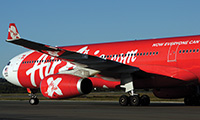News Backgrounder
MAS’s rescue and resuscitation
Khazanah Naisonal’s “airline doctors”, put in charge of saving Malaysia Airlines (MAS), have opted for leadership stability as they begin corporate surgery at the nation’s flag carrier.
October 1st 2014
Consensus has still be reached about the viability of Khazanah Nasional’s US$1.9 billion rescue package for Malaysia Airlines (MAS) as critics contend that de-listing the carrier will not produce the reforms necessary at the distressed airline. Read More »
In late August, Khazanah’s managing director, Azman Mokhtar, outlined plans for MAS after it becomes 100% owned by the government fund. His goal is to return the flag carrier to profitability by 2017 – without a change to its name.
 |
| MAS withdrawal from long-haul routes could take AirAsia X back to Europe |
Under the plan almost a third of the airline’s workforce will lose their jobs as MAS is converted into a regional carrier stripped of several loss-making international routes often serviced by the airline’s A380 fleet.
“The combination of measures will enable our national airline to be revived, said Azman.
Khazanah wants MAS’s cost per average seat kilometre (CASK), a metric for cost efficiency, to be within 15% of low-cost carriers and be close to the performance of similar to carriers, such as Emirates Airline, but below regional competitors, Singapore Airlines and Cathay Pacific Airways. MAS flies to seven cities beyond the Asia-Pacific: Amsterdam, Dubai, Frankfurt, Istanbul, Jeddah, London Heathrow and Paris.
Buenos Aires, Cape Town, Johannesburg and Rome were eliminated from the network in 2012 and Los Angeles was dropped in April. It is expected that Frankfurt and Paris may be the first to go, with MAS filling the network gap with its oneworld partners in Europe.
Azman also hinted that Khazanah could sell equity in the carrier to private sector investors, which suggests if MAS does rebound to profit, it could be open to a strategic investment by a foreign airline partner.
AirAsia Group boss, Tony Fernandes, said the revival strategy would benefit both MAS and his carrier. “We welcome it. Its good to have two strong carriers,” he said.
But vehement critic of the Khazanah plan, Shukor Yusof, of aviation consultancy Endau Analytics, said the three-year plan was essentially a government bailout that was piecemeal and guilty of wishful thinking about returning to profit in three years. Yusof added that if the airline kept its six A380s, he “was convinced the airline would never make money”.
Another analyst, who did not wish to be named, considered the rescue plan might succeed because it included massive job cuts, which were absent from previous MAS restructurings.
Aviation consultancy, CAPA, said the MAS privatization will only become realistic if the recovery plan is executed flawlessly and market conditions, which have been brutal in Southeast Asia in the last year, become more favourable.
It said cuts to the long-haul network could create a void in the market and persuade airlines like AirAsia X to reconsider Europe. It also could lead to an opening for oneworld partners, such as British Airways and Finnair, to become joint venture partners with MAS.
Tony Fernandes said: “It seems Khazanah Nasional genuinely wants MAS to be run commercially.”
Fernandes said there is currently too much crossover between the two airlines routes networks, which was inefficient. MAS had been able to price its fares aggressively and beyond its means because it had the support of the Government, he said. Fernandes hoped the restructure would result in a healthy aviation industry and less taxpayer money being used to prop up the ailing MAS. AirAsia would “do its best” to absorb as many people as it could from those who had lost their jobs at MAS, Fernandes promised.
The restructuring was announced as MAS reported its fifth consecutive quarterly loss, a $97.5 million deficit in the three months to June 30. The results brought losses for the first half of 2014 to $238.3 million. Some analysts forecast the full year loss could reach $1 billion.